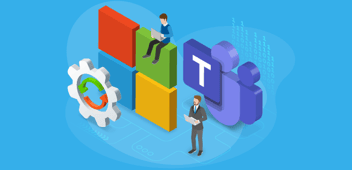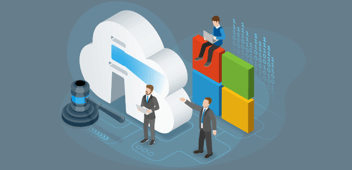Your Microsoft 365 tenant may already be full of AI agents you didn’t authorize. From custom bots built in Copilot Studio to workflow agents created in Power Platform, these digital workers are multiplying fast. For CIOs and IT leaders, the critical question isn't if you will adopt them, but how you will govern them.
Without a robust governance framework, the promise of AI-driven efficiency can quickly devolve into a landscape of security vulnerabilities, compliance breaches, and spiraling costs. But managing this complexity doesn't have to be a burden. With the right tools and insights, you can empower your organization to innovate safely, turning potential chaos into controlled, measurable success.
This article provides a comprehensive look at the world of Microsoft AI agents, the tangible risks they present, and a clear, data-driven path to governing them effectively.
Understanding Microsoft AI agents:
The new digital workforce
AI agents are already woven into the daily workflows of Microsoft 365. From drafting documents in Word to automating multi-step business processes in Power Platform, these agents form a new layer of intelligent assistants inside the enterprise. To govern them effectively, you first need a clear understanding of what they are, how they function, and where they operate.
What are Microsoft AI agents?
Microsoft AI agents are autonomous digital workers powered by large language models and Microsoft 365 services, designed to understand goals, make informed decisions, and take targeted actions. They go far beyond traditional chatbots or static automations. Instead of simply answering a question, an agent can plan and execute multi-step workflows, integrate with business systems, and collaborate with both people and other agents as part of multi-agent systems.
They exist on a spectrum:
- Microsoft Copilot: The general-purpose AI assistant embedded directly into core productivity apps like Word, Excel, PowerPoint, Outlook, and Teams. It provides contextual help (drafting text, analyzing data, summarizing meetings) and complements the specialized AI agents built for broader workflows.
- Copilot Studio: Microsoft’s low-code platform to customize Copilot or build specialized agents from scratch. Business units can connect agents to back-end systems, define their conversational logic, and publish them across internal or external channels. Here’s how Copilot Studio fits into the Microsoft 365 landscape and how it compares to other agent-building tools.
- Power Platform agents: Built using Power Automate and Power Apps, these agents can trigger complex workflows across hundreds of apps, both inside and outside Microsoft 365.
- SharePoint agents: Purpose-built agents for managing content lifecycles, enforcing metadata policies, and surfacing the right information in knowledge-intensive environments. For a deeper dive, see our article on SharePoint agents and ensuring IT oversight.
Where do Microsoft AI agents live and work?
Microsoft AI agents operate in different parts of the Microsoft 365 ecosystem, depending on how they are designed:
- Collaboration hubs: SharePoint and OneDrive — where agents can enforce document policies, manage permissions, or surface knowledge.
- Low-code platforms: Power Apps and Power Automate — where citizen developers create process automation agents.
- Core productivity apps: Word, Excel, PowerPoint, Outlook, and Teams — home to the built-in Copilot assistant, but also places where custom AI agents can surface, for example, generating reports in Excel, drafting presentations in PowerPoint, or engaging with users directly in Teams.
- Custom environments: Websites, chat channels, or business systems — where Copilot Studio agents can be deployed for specific use cases.
To support this agent ecosystem, Microsoft offers Copilot Studio’s Agent Builder, which gives both IT and business users the ability to create, manage, and deploy AI agents with minimal coding. While this democratization of development fuels innovation, it also highlights the need for clear governance guardrails.
From Copilot to autonomous agents: The agentic shift
The real paradigm shift is the move from reactive assistants to proactive, autonomous agents. A classic automation follows a rigid, predefined script. An AI agent, however, can be given a goal and a set of tools (like access to an API or a database) and can then independently formulate and execute a plan to achieve that goal.
This is the "agentic" model of AI. We are witnessing the rise of multi-agent systems and workflows, where several specialized agents collaborate to complete a task that would be too complex for a single agent. For example, a "sales inquiry" agent could receive a customer email, pass the details to a "CRM lookup" agent to retrieve the customer's history, which then hands off to a "report generation" agent to summarize the opportunity for the sales team.
Learning how to build a Copilot agent effectively means thinking beyond a single task and preparing for scenarios where agents collaborate, adapt, and scale across business processes. This is the future of work that Microsoft is building towards, and it's happening faster than most organizations are prepared for.
|
Type |
How it works |
Limitations |
Example |
|
Traditional automation |
Follows a rigid, predefined script with fixed steps. |
Can’t adapt to changing inputs or goals. |
A Power Automate flow that moves files from one folder to another. |
|
AI assistant |
Provides contextual help inside applications (e.g., drafting, summarizing, analyzing). |
Reactive only, cannot act independently or across systems. |
Microsoft Copilot drafting text in Word or summarizing an Outlook email thread. |
|
AI agent |
Given a goal and a set of tools (API, database, large language model). Independently reasons, plans, and executes steps to achieve the goal. |
More complex to monitor and govern. |
An HR onboarding agent that provisions access, answers questions, and books meetings. |
|
Multi-agent system |
Several specialized agents collaborate to complete tasks too complex for one agent. |
Coordination adds risk without governance. |
A “sales inquiry” agent hands data to a “CRM lookup” agent, which then triggers a “report generation” agent. |
Real-world use cases and AI agents examples
To understand their impact, let's look at some practical AI agent examples across different business functions. These scenarios show how organizations are already building AI agents to solve everyday challenges and streamline complex processes:
- HR onboarding: An AI agent can guide a new hire through their first week, answering policy questions, provisioning access to necessary tools, and scheduling introductory meetings, all through a conversational interface in Microsoft Teams.
- Financial reporting: A finance team could deploy an agent that automatically pulls sales data from Dynamics 365, expense figures from SAP, and market trends from an external API to generate a draft of the quarterly performance report in PowerPoint.
- IT service desk: Instead of a simple chatbot, an IT agent can diagnose a user's problem, attempt automated remediation steps (like clearing a cache or resetting a password), and only create a ticket with full diagnostic logs if it cannot resolve the issue itself.
- Knowledge management: A custom Copilot can be trained exclusively on your internal documentation, engineering wikis, and product specs. This creates a highly accurate "expert" agent that can answer complex technical questions for support staff or new developers, preventing them from relying on outdated or public information.
Copilot chaos: The hidden risks of ungoverned AI agents
While these use cases are compelling, each one carries inherent risks if deployed without centralized oversight. The very ease of creation that makes these tools so powerful is also their greatest governance challenge, especially as more business users start building agents on their own without IT visibility.
1. The danger of agent sprawl and "shadow agents"
When any user with a license can build and deploy a Microsoft agent, IT quickly loses visibility. This leads to agent sprawl, a tangled web of undocumented, unmanaged, and often redundant agents.
- The pain point: Every untracked agent is a question mark. Who built that agent connecting to the finance database? What data is it accessing? When was it last updated? Is its owner still with the company? These "shadow agents" represent a massive blind spot for security and operations teams.
- The governance solution: A centralized governance platform is essential. Solutions like Rencore Governance provide a complete inventory of all agents across your Microsoft 365 and Power Platform tenants. They enable you to detect and classify every active agent, manage its entire lifecycle from creation to retirement, and trace its activity, giving you the 360° visibility you need to regain control.
2. Misinformation and data quality risks
An AI agent is only as good as the data it can access. If your Microsoft 365 environment suffers from poor information hygiene (stale documents, orphaned sites, unclear data ownership, and duplicate content), your agents will amplify this chaos instead of providing up-to-date and reliable insights.
- The pain point: When an agent surfaces a recommendation based on an outdated policy document or a draft sales figure, it doesn't just provide a wrong answer. It creates a risk of poor business decisions and erodes user trust in the AI investment.
- The governance solution: Effective governance starts with data quality. Rencore provides deep insights into your content, allowing you to identify stale, orphaned, or duplicate files before they pollute your AI's knowledge base. By cleaning up your tenant and establishing a clear information architecture, you ensure your Microsoft AI agents are working with accurate, reliable content.
3. Compliance, security, and GDPR risks
Ungoverned agents are a direct threat to your security and compliance posture. An improperly configured agent could inadvertently share sensitive PII from an HR system, expose intellectual property by using an insecure third-party connector, or violate data residency requirements under GDPR.
- The pain point: How can you prove to auditors that your AI usage is compliant? How do you prevent an agent built by the marketing team from accessing sensitive R&D data? The risk of unintended data sharing and unauthorized access is immense.
- The governance solution: You need automated policy enforcement. With Rencore, you can set clear boundaries for what agents can do, which connectors they can use, and what data they can access. Our platform allows you to automate access reviews, enforce policies, and maintain detailed audit trails, ensuring you are always audit-ready while empowering your teams to innovate.
Why enterprise governance is non-negotiable for AI agents
Microsoft provides a powerful set of tools, but its native governance capabilities often leave critical gaps that enterprises must fill. While Microsoft offers controls for building agents, it provides less oversight for their entire lifecycle, including ownership, cost attribution, and eventual decommissioning.
This is where a dedicated governance layer becomes essential. We’ve outlined this in more detail in our blog on governing the age of AI with Copilot agent governance and Power Platform oversight.
Effective governance for Microsoft AI agents is built on five pillars:
- Centralized visibility: Create a single dashboard to see every agent, its owner, its purpose, its connections, and its activity.
- Lifecycle management: Automate processes for provisioning new agents based on business justification and de-provisioning them when they become inactive or their owner leaves.
- Policy-based automation: Define and automatically enforce rules for agent creation, data access, and connector usage, with alerts for violations.
- License and cost transparency: Use dashboards to track Copilot and Power Platform license usage, attribute costs to specific departments, and measure the ROI of your AI initiatives.
- Integrated M365 policies: Ensure that your AI agent governance is not a silo but is fully integrated with your existing governance policies for SharePoint, Teams, and the wider M365 ecosystem. Rencore Governance brings these capabilities together in one centralized platform, designed to help you master the complexities of your Microsoft 365 and Power Platform environments.
Best practices for managing Microsoft AI agents at scale
Ready to move forward? Here is a practical, three-step approach to establishing robust governance for your AI agents.
1. Inventory and map all agents
Your first step is to establish a complete and continuous inventory. You need to know what's running in your tenant right now. This isn't a one-time project; it's an ongoing process of discovery. It's foundational for both compliance and cost control, helping you identify redundant agents and optimize license allocation.
2. Define your policies early
Don't wait for a problem to occur. Proactively define the rules of the road for AI agent development and deployment. Your policies should address:
- Creation: Who is allowed to build agents? Is there an approval process?
- Data access: What are the default data sensitivity levels an agent can access?
- Purpose: Must every agent have a documented business case and an owner?
- Lifespan: Should agents be reviewed or recertified periodically to prevent them from becoming orphaned?
3. Automate enforcement and reporting
Manual governance doesn't scale. The only way to manage hundreds or thousands of agents is through automation. Implement a system that can automatically detect policy violations, alert the agent owner or IT, and provide clear dashboards for tracking compliance over time. This makes governance scalable, auditable, and measurable. To achieve this, you need to explore how to master Microsoft 365 AI governance from the ground up.
The future is governed: Embrace AI agents with confidence
Microsoft AI agents represent one of the most significant shifts in enterprise technology in a decade. They offer a path to unprecedented productivity and innovation. But this power demands responsibility. Organizations that embrace AI without a parallel commitment to governance are exposing themselves to significant security, compliance, and financial risks.
The future of work will be built on collaboration between humans and AI agents. Those who act now to implement a robust governance framework will not only mitigate risk but will also build a foundation of trust that accelerates adoption and maximizes the return on their AI investment. With a partner like Rencore, you can lead the next phase of digital transformation with confidence.
Frequently asked questions (FAQ)
What are Microsoft AI agents?
Microsoft AI agents are autonomous software programs designed to perform tasks and achieve goals within the Microsoft 365 ecosystem. They range from the general-purpose Microsoft Copilot assistant to specialized, custom-built agents created with tools like Copilot Studio and Power Platform to automate specific business processes.
How do Copilot agents differ from traditional automation?
Traditional automation follows a rigid set of predefined rules. Copilot agents and other AI agents, by contrast, can be given a goal and independently reason, plan, and execute steps. This makes them flexible, adaptable, and able to complete tasks that would be far beyond the scope of traditional automation.
What risks do AI agents create in Microsoft 365 environments?
The main risks include agent sprawl with undocumented shadow agents, misinformation from outdated content, security breaches through misconfigured access, compliance violations such as GDPR breaches, and cost inefficiency from redundant agents and underused licenses.
How can IT departments govern Copilot agents at scale?
Scalable governance requires a dedicated platform that provides:
- A complete and automated inventory of all agents.
- Automated lifecycle management (provisioning and deprovisioning).
- A flexible engine to enforce policies on data access, connectors, and sharing.
- Centralized dashboards for monitoring activity, compliance, and costs.
Is Microsoft Copilot Studio the same as Agent Builder?
Microsoft Copilot Studio is the primary low-code tool for building and customizing Copilot agents. The term "Agent Builder" is often used more generically to describe the capabilities within Copilot Studio and the broader Power Platform for creating these agents.
Can AI agents affect data privacy and compliance?
Yes. An agent is a non-human identity that can access, process, and share data. Without strict governance, it may expose sensitive information and violate GDPR. Organizations must train teams on the security and compliance implications of agent design.
Do I need governance if we’re only starting with a few agents?
Yes. Governance isn’t just for large-scale deployments. Even a handful of agents can access sensitive data or create compliance risks if left unmanaged. By putting clear policies and oversight in place early, you set a strong foundation that will scale smoothly as adoption grows.
What is the Azure AI Foundry Agent Service?
The Azure AI Foundry Agent Service (formerly Azure AI Agent Service) is Microsoft’s platform for building, deploying, and managing AI agents in the Azure cloud. Unlike Microsoft 365 Copilot agents, these custom-built applications use Azure AI services such as Azure OpenAI, Cognitive Search, and Cognitive Services to perform autonomous tasks, orchestrate workflows, and collaborate with multiple agents.




